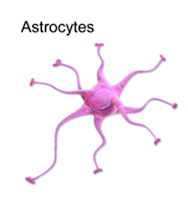Neuron is the basic structural and functional unit of nervous system
Around 75 billion neurons are present in the nervous system
The nervous system acts as a major control system in our body, the
other one being the Endocrine system
A neuron is similar to other cells in the body but have special
structure and function
Labeled diagram of a Neuron
Cell body (Soma)
- It is also called as Soma.
- Signals from dendrites are joined here and passed on.
- It contains nucleus and other organelles, mainly the Nissl granules which synthesise neurotransmitters.
- Neurotransmitters are then transported via Axoplasmic flow to the axon terminal where they are stored in vesicles.
Dendrites
- They are thin structures that are extensions of the cell body.
- Their function is to receive nerve impulses from other cells and to carry them to the cell body.
Axon
- It is a long, thin extension of the cell body.
- It transmits nerve impulses away from the cell body.
- The axon branches at the end, forming multiple axon terminals where the neurotransmitters are stored in the vesicles.
Types of neurons
There are different types of neurons based on the number of axons and
dendrites – They are
- Unipolar neuron
- Bipolar
- Pseudo-unipolar neuron
- Multipolar neuron
Unipolar neurons
- Usually found only in invertebrate species. They have a single axon.
Bipolar neurons
- Bipolar neurons have two extensions extending from the cell body. At the end of one side is the axon, and the dendrites are on the other side. These types of neurons are mostly found in the retina of the eye. But they can also be found in parts of the nervous system that help the nose and ear function.
Multipolar neurons
- These neurons have a single axon and symmetrical dendrites that extend from it. This is the most common form of neuron in the central nervous system.
Neuroglia
They are the cells which give support and protection to the neurons.
There are different types of neuroglia, which are
- Microglia
- Oligodentrocytes
- Astrocytes
Microglia
- They resemble macrophages.
- Act as scavenger cells, remove debris and dead bacteria from CNS by phagocytosis.
Oligodendrocytes
- They form myelin sheath around the axons.
- They insulate the axon and limit the flow of current around it.
Astrocytes
- They are responsible for formation of blood brain barrier.
- They maintain a constant level of K+ ion in the CNS.
- They help in resynthesis of neurotransmitter Glutamate.





No comments:
Post a Comment